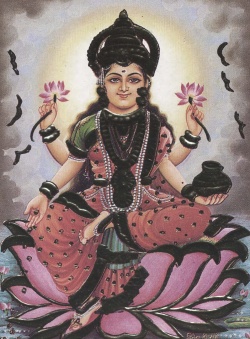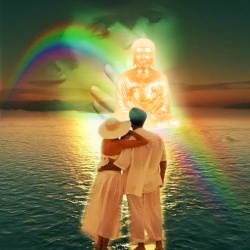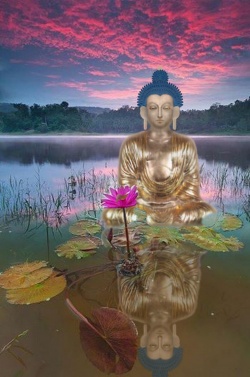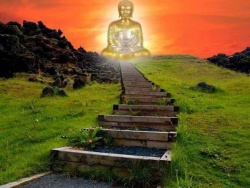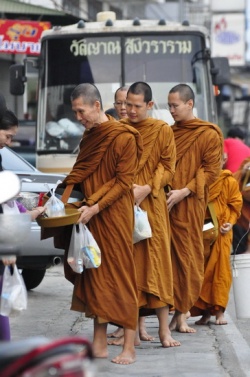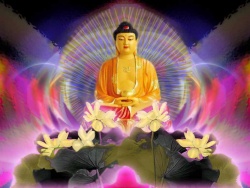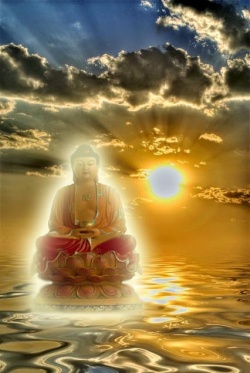Wheel Of Time Tantra (kalācakra) Bibliography from the THL Bibliographies
Wheel Of Time Tantra (kalācakra) Bibliography from the THL Bibliographies
Overview of Subject
The Kālacakratantra is one of the last great tantric traditions to arise in India. Although many scholars place its roots in eleventh century, the traditional account of this tantra’s origins traces its beginnings to the historical Buddha.
First transmitted from Śākyamuni Buddha to King Sucandra of the mythical land of Śambhala, it was condensed into an abbreviated version - the version available to us - by the eighth king of Śambhala, Mañjuśri Yaśas.
Mañjuśri Yaśas’ successor Puṇdarīka in turn composed the commentary Vimalaprabhā ("stainless light"), which to this day, remains the most authoritative commentary to this tantra.
First translated by Gyijo Öser in the eleventh century in Tibet, the Kālacakratantra would come to be translated over fourteen times, spawning two influential spiritual traditions: the Dro and the Ra.
The tantra became the locus of inspiration for religious ideology, literature and practice in Tibet, most especially after the fourteenth century.
Main themes of this tantra include the fundamental correspondences between human psycho-physiology and the universe, between bodily energies and mental states, and between mundane reality and enlightened reality.
Since its entry into Tibet, the importance of the Kālacakratantra to the Tibetan conception of Buddhism cannot be overemphasized.
Overview of the Bibliography
Despite having been studied assiduously in Tibet since the 12th century, Western scholarship on the Kālacakratantra is relatively sparse.
The first study of the Kālacakratantra was done by Alexander Csoma de Körös in 1833, and subsequent scholars of this text include George N. Roerich, and Helmut Hoffman who both worked in the mid-19th century.
Roerich was important for pointing out the wealth of Tibetan literature available on this subject and Hoffman made significant progress in establishing the historical context of the Kālacakratantra.
In modern times, the stars, so to speak, of Kālacakratantra studies in the West are undoubtedly John Newman and Vesna Wallace.
In addition to publishing a dissertation that represents the first attempt since 1959 to translate the first chapter of the Kālacakratantra and its commentary the Vimalaprabhā, John Newman has written various articles that examine various facets of the Kālacakratantra.
Newman’s work is characterized by a methodological approach sensitive to the Tibetan Buddhist tradition, and is primarily concerned with figuring out the contents of the Kālacakratantra and the sociological and historical dimensions of this text.
In contrast to Newman, Wallace’s work is characterized by a bolder interpretative approach, but her work builds in many ways upon the work of Newman. Wallace translates the second chapter of the Kālacakratantra.
In her 2001 The Inner Kālacakratantra:
The Buddhist Tantric View of the Individual, she uses the interpretative framework of the metaphorical “body” to explore the Kālacakratantra.
From the emic perspective of Kālacakratantra studies in modern times, the work of the 14th Dalai Lama H.H. Tenzin Gyatso, Geshe Lhundub Sopa and Geshe Ngawang Dhargey have been invaluable in helping us to understand the practice tradition associated with this text.
Of course, one must also not neglect the extensive work on the Kālacakratantra done by previous Tibetan scholars.
Although this bibliography includes the work of Jamgön Kongtrul Lodrö Tayé (15th century) and Khedrup Norsang Gyatso (19th century), it is by no means exhaustive in its listing of works by Tibetan Buddhist works on the Kālacakratantra.
This is a present shortcoming that will hopefully be rectified in the future.
Contributors
Rachel Pang, April 2007
Bibliography
Books
Translations
Newman, John. Dissertation: The Outer Wheel of Time: Vajrayàna Buddhist Cosmology in the Kālacakratantra. Ph.D. conferred December 20, 1987. This represents one of the first attempts by modern Western scholarship to provide a careful, accurate, and scholarly translation of Śrī Kālacakra I. 1-27, I. 128-170 and its commentary, the Vimalaprabhā I. 1.1-1.9.27, I. 10.128-149. A seminal work written by the one of the foremost experts on the Kālacakratantra in the Western academy. Part I of his dissertation focuses on topics as general as tantra, the position of tantra within Buddhism, and the possible methodological approaches to studying Buddhist tantra. It then proceeds to outline problems of chronology in studying ancient Indian texts like the Kālacakratantra that lack definitive dates. After outlining the history of this text in India, Newman concludes with a general survey of the contents of the Kālacakratantra, an analysis of the content of its first chapter, and a literature review. Part II consists solely of his translation.
Kalacakratantra: The Chapter On The Sadhana Together With The Vimalaprabha. New York: Columbia University Press, 2007.
Kālacakratantra: The Chapter On The Individual Together With The Vimalaprabha. Trans. Vesna Wallace. New York : Columbia University Press, 2004.
Interpretative Works
Traditional Tibetan
Cozort, Daniel (1986). Highest Yoga Tantra. Ithaca, NY: Snow Lion Publications. Pp. 117-133 compares the Guhyasamaja and Kalacakra. Dhargyey, Ngawang. A commentary on the Kālacakra Tantra. Trans. Allan Wallace. Dharmasala, Himachal Pradesh : Library of Tibetan Works & Archives, 1985.
Gyatso , Khedrup Norsang. Ornament of Stainless Light: An Exposition of the Kālacakra Tantra. Boston: Wisdom Publications, 2004. Ornament of Stainless Light - its title being a play on the main commentary on the Kālacakratantra, Stainless Light - is one of the classic commentaries on this tantra. Its author Khedrup Norsang Gyatso (1423-1513) provides a clear elucidation of all five sections of the tantra. The general outline of his work is as follows: after tracing the history of this text back to the Buddha, he establishes the primordial mind and body as the principal themes of the highest yoga tantras (and thus the Kālacakratantra), explains the intentions of the highest yoga tantras, and finally discusses the content of the Kālacakratantra itself using the traditional thematic division of Outer, Inner, and Other (26). He discusses the Kālacakratantra following the organization of the original tantra: the external world, the inner world, initiations, the generation stage and the completion stage.
Tenzin Gyatso, the Dalai Lama and Jeffrey Hopkins (1989, revised edition). Kalachakra Tantra: Rite of Initiation. London and Newburyport: Wisdom Publications
Jamgon Kongtrul Lodrö Tayé . Myriad Worlds. Ithaca: Snow Lion Publications, 1995. This work covers Buddhist cosmology in the Abhidharma, the Kālacakratantra, and Dzog-chen.
Gen Lamrimpa, translated by B. Alan Wallace (1999). Transcending Time: An Explanation of the Kālacakra Six-Session Guru Yoga. Boston: Wisdom Publicaitons.
Western Scholarship
Geshe Lhundub Sopa, Roger Jackson and John Newman (1985). The Wheel of Time: The Kalachakra in Context. Madison, WI: Deer Park Books. This was republished in 1985 - Ithaca, NY: Snow Lion Publication. Wisdom is publishing a translation of a commentary on the Vimalaprabha by Khedrup Norsang Gyatso (d. 1513) to be out in summer of 2004. external link: http://www.wisdompubs.org/products/0861714520.cfm
Bryant, Barry. The wheel of time sand mandala : visual scripture of Tibetan Buddhism. Ithaca. : Snow Lion Publications, 2003. The preface is by Richard Gere with a forward by H.H. Dalai Lama.
Davidson sections.
Jackson, Roger, John Newman and Geshe Lhundup Sopa. The Wheel of Time. Ithaca: Snow Lion Publications, 1991.
Mullin, Glenn H. (1991). The Practice of Kalachakra. Ithaca, New York: Snow Lion Publications.
Wallace, Vesna. The Inner Kalacakratantra: A Buddhist Tantric View of the Individual. New York : Oxford University Press, 2001. In this interpretative work, Vesna Wallace frames the Kālacakratantra within the greater social and Buddhist ideological framework of eleventh century India.
She approaches the text of the tantra from four interpretative angles all revolving around the concept of the "body." These subsections are the Cosmic Body, the Social Body, the Gnostic Body, the Transformative Body.
Websites
Kalacakra. [external link: http://kalacakra.org/].
Articles
Damdinsuren, Ts. "A commentary on Kalacakra or wheel of time." Tibet Journal 6.1 (1981): 43-49.
Gronbold, Gunter. "The date of the Buddha according to Kalacakra mythology." Indian Journal of Buddhist Studies 6.1-2 (1994) 7-14.
Geshe Lhundub Sopa. “The Subtle Body in Kalachakra”, pp. 133-158.
Newman, John. “A Brief History of the Kalachakra” . 51-84.
Newman, John. “Kalacakra.” Robert E. Buswell, Jr., ed., Encyclopedia of Buddhism. New York: Macmillan Reference, 2003.
Newman, John. "Vajrayoga in the Kàlacakra Tantra." In Tantra in Practice, ed. David G. White. Pp. 587-94. Princeton Readings in Religions. Princeton: Princeton University Press, 2000.
This article takes an interpretative look at the practices associated with the Kālacakratantra and argues that such techniques are based on Mahayana philosophy
Newman, John."Islam in the Kàlacakra Tantra." The Journal of the International Association of Buddhist Studies 21 (1998): 311-71.
This article examines how the Kālacakratantra was in part a historical response to the Islamic invasions of 11th century India.
Newman, John."The Epoch of the Kàlacakra Tantra." Indo-Iranian Journal 41 (1998): 1-31. This article contains complex calculations that address the issue of the dating of the Kālacakratantra
Newman, John."Itineraries to Sambhala." In Tibetan Literature: Studies in Genre, ed. José Ignacio Cabezón and Roger Jackson. Pp. 485-99. Studies in Indo-Tibetan Buddhism Series. Ithaca: Snow Lion Publications, 1996. This article is an interpretative work on a genre of Tibetan literature—the lam yig—that describes the pilgrimage route to the mystical land of Sambhala in which the Kālacakratantra was preserved for centuries.
Newman, John."Eschatology in the Wheel of Time Tantra." In Buddhism in Practice, ed. Donald S. Lopez, Jr. Pp. 284-89. Princeton Readings in Religions. Princeton: Princeton University Press, 1995.
Newman, John."Buddhist Siddhànta in the Kàlacakra Tantra." Wiener Zeitschrift für die Kunde Südasiens 36 (1992): 227-34. This article examines eight verses from the Kālacakratantra quoted from Aryadeva’s Jñānasārasamucaya that discuss Vaibhāsika, Sautrāntrika, Yogācāra, and Madhyamaka philosophies.
Newman, John. "Buddhist Sanskrit in the Kàlacakra Tantra." The Journal of the International Association of Buddhist Studies 11 (1988): 123-40. In this article, Newman argues that the “corrupt” Sanskrit grammar in the Kālacakratantra was not the result of inept authors but rather served a pedagogical purpose
Newman, John. "The Paramàdibuddha (the Kàlacakra målatantra) and Its Relation to the Early Kàlacakra Literature." Indo-Iranian Journal 30 (1987): 93-102. This article reacts against speculations that the original mulatantra, upon which the current laghunatantra of the Kālacakratantra is based, did not exist
Newman, John and Geshe Wangdrak. "An Introduction to the Kalachakra." Chö-yang 1 (1986): 17-20.
